
Searsia pyroides, previously known as Rhus pyroides, is a species of Searsia, native to southern Africa. This tree occurs throughout the whole of South Africa, a part of Botswana, Zimbabwe and Tanzania and in some areas of Namibia near Windhoek.
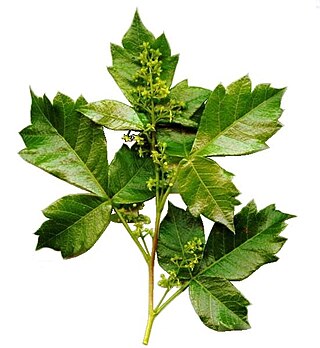
Searsia dentata, the nana-berry (English), or nanabessie (Afrikaans), is a medium-sized, deciduous tree, reaching a height of about 5 metres and a spread of 4 metres, and with a tendency to scramble through and over neighbouring trees. It occurs naturally in almost the whole of South Africa except the Western and Northern Cape Provinces. Its habitat varies from sea level to the highlands of the Drakensberg. It is frost-hardy and should be planted in full sun. The strongly aromatic leaves are usually conspicuously toothed, though sometimes they may be only slightly toothed. The tree produces small, creamy-white flowers in masses, developing into small, flattened drupes (5-6mm) which turn red or orange when ripe and brown when dry. The ripe fruits are eaten by birds, while the foliage is food for the larvae of the pepper tree moth Bombycomorpha bifascia.
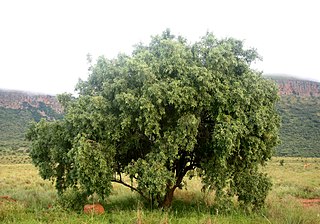
Searsia leptodictya is known as mountain karee in English, bergkaree in Afrikaans, and mohlwehlwe in Sotho. An evergreen tree reaching a height of 5 metres and a similar spread, it is drought resistant but only semi frost hardy. It is an attractive small tree with a rounded crown and a pleasing weeping effect. It can be planted in full sun or in partial shade. The tree bears small white flowers, which on female trees turn into bunches of small berry type fruit, which attract birds who feed on the berries. The tree is an attractive tree for a small garden. The berries can be brewed into a beer.
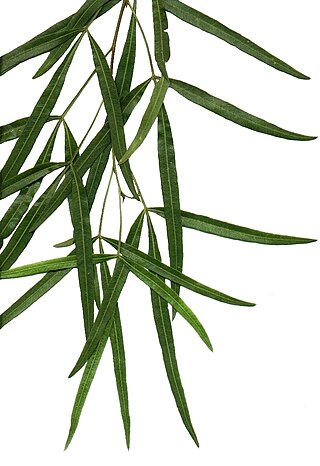
Searsia lancea commonly known as karee, is an evergreen, frost hardy, drought resistant tree, which can reach up to 8 metres in height with a 5-metre spread. It is one of the most common trees on the Highveld and in the Bushveld in South Africa, but not found in the Lowveld. In North America, where it is naturalized, it is known as African sumac and willow rhus.
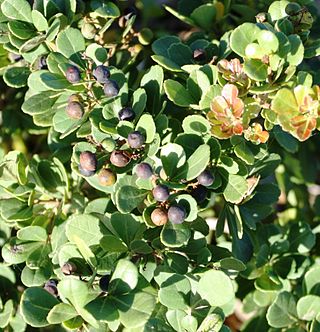
Searsia crenata, previously known as Rhus crenata,, is a species of Searsia that is native to South Africa, where it grows in frost-free and light frost areas, especially on beach sand dunes.
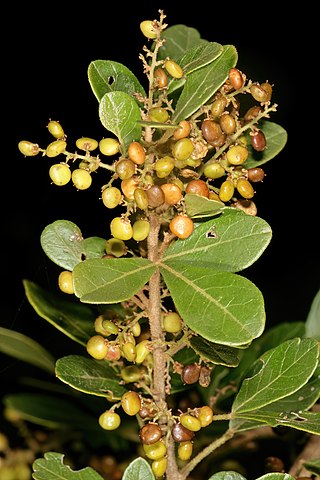
Searsia pentheri, the common crowberry (English), gewone kraaibessie (Afrikaans), iNhlokoshiyane (Zulu), or mutasiri (Venda), is a species of tree in the genus Searsia. Frost hardy tree reaching a height of up to 6 metres. The tree is mainly evergreen but loses its leaves in severe winters. It has olive-green foliage with dark brown bark and can be grown in either full sun or semi shade. Small flowers are produced and are followed by masses of shiny, light brown, small edible fruits, which provide a feast for birds. Only female trees produce these fruits though. The tree occurs over large portions of South Africa. It has been planted in Spain.
Searsia gerrardii, the Drakensberg karee, is a deciduous, drought resistant tree, native to South Africa. It reaches a height of up to 5 metres. It is frost hardy and occurs naturally in mountain areas, often along riverbanks. The tree has a graceful drooping habit. It produces small yellowish flowers which, on female trees, turn into small fruits which are relished by birds. This tree makes a lovely shade tree for a small garden.
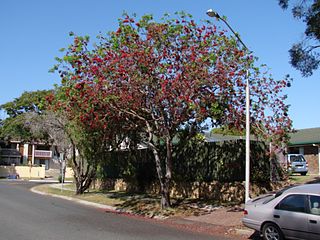
Schotia brachypetala, the weeping boer-bean, is a leguminous flowering tree in the family Fabaceae and the subfamily Detarioideae. The woodland tree is native to Africa south of the Zambezi River, where it occurs at middle altitudes. It is well-suited as shade or ornamental tree in warmer regions, and is consequently widely cultivated in gardens and parks. It is named for the copious nectar that drips from its flowers, which attracts various species of birds and insects. It is known by various other names, including tree fuchsia, African greenheart and African walnut.
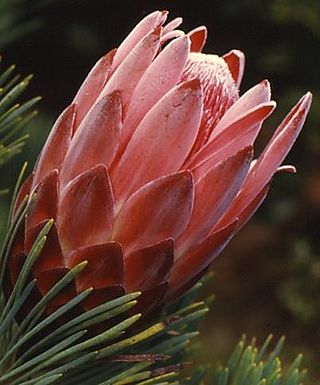
Protea aristata is a compact shrub with beautiful flowers which is endemic to the southwestern part of the Cape Region of South Africa. P. aristata has become one of South Africa's most famous proteas in spite of its relatively late discovery, and re-discovery in 1953. The leaves are soft, dense and needle-like and the flower heads are a stunning crimson red, it may thus be a good potential ornamental plant for South African gardens. It is usually called the Ladismith sugarbush in South African English, although it has been called pine sugar bush in Australia. In the Afrikaans language it has the vernacular name of klein-den-suikerbos.

Populus grandidentata, commonly called large-tooth aspen, big-tooth aspen, American aspen, Canadian poplar, or white poplar, is a deciduous tree native to eastern North America.
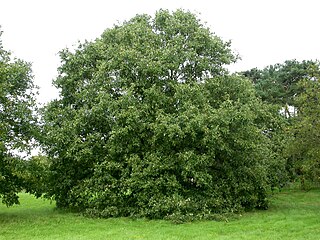
Quercus libani, the Lebanon oak, is a species of oak native to the eastern Mediterranean in western Asia, including in Lebanon, western Syria, northeastern Israel, eastern Turkey, and northern Iraq and Iran.

Celtis africana, the white stinkwood, is a deciduous tree in the family Cannabaceae. Its habit ranges from a tall tree in forest to a medium-sized tree in bushveld and open country, and a shrub on rocky soil. It occurs in Yemen and over large parts of Africa south of the Sahara. It is a common tree in the south and east of southern Africa, where the odour given off by freshly-cut green timber is similar to that of Ocotea bullata or black stinkwood.

Cunonia capensis, the butterspoon tree, butterknife tree, African red alder, red alder or rooiels, is a small tree found in the afromontane forests of southern Africa, and along rivers. It is grown as an ornamental in gardens for its attractive glossy foliage and its clusters of tiny, scented, white flowers. It is the only one of 24 species of Cunonia to occur outside of New Caledonia in the Pacific.

Diospyros whyteana is a small African tree of the ebony family. Bearing dark green, strikingly glossy leaves and creamy fragrant flowers, it is increasingly cultivated in Southern African gardens as an attractive and strong ornamental tree. It can attain a height of up to 6 m.
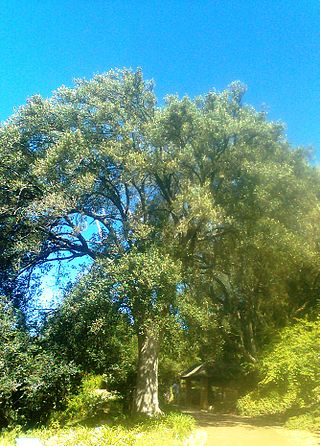
Kiggelaria africana is a large, robust, low-branching African tree, and is currently the only accepted species in the genus Kiggelaria.

Ilex mitis is a tall, dense, evergreen tree that is indigenous to Sub-Saharan Africa and Madagascar. It makes an excellent fast-growing hedge for gardens - growing tall, straight and dense.

Podalyria calyptrata is a small, resilient, fast-growing tree of the Fabaceae (legume) family. It has velvety silver leaves, bears masses of bright-pink, sweetly scented flowers, and is indigenous to the Western Cape, South Africa.
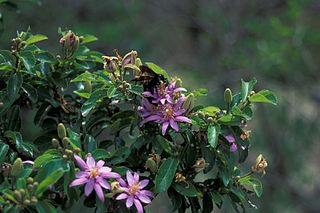
Grewia occidentalis, the crossberry, is a species of deciduous tree indigenous to Southern Africa.
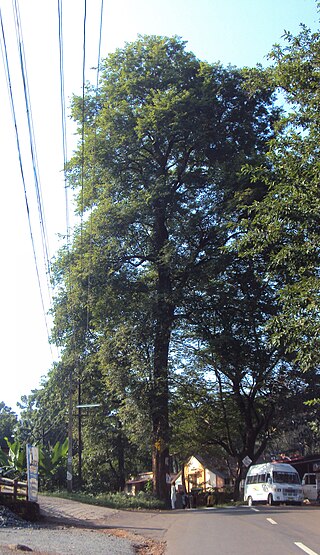
Dalbergia latifolia is a premier timber species, also known as the Indian rosewood. It is native to low-elevation tropical monsoon forests of south east India. Some common names in English include rosewood, Bombay blackwood, roseta rosewood, East Indian rosewood, reddish-brown rosewood, Indian palisandre, and Java palisandre. Its Indian common names are beete, and satisal. The tree grows to 40 metres (130 ft) in height and is evergreen, but locally deciduous in drier subpopulations.

Senegalia nigrescens, the knobthorn, is a deciduous African tree, growing up to 18 m tall, that is found in savanna regions from West Africa to South Africa. The tree is resistant to drought, not resistant to frost and its hard wood is resistant to termites.






















